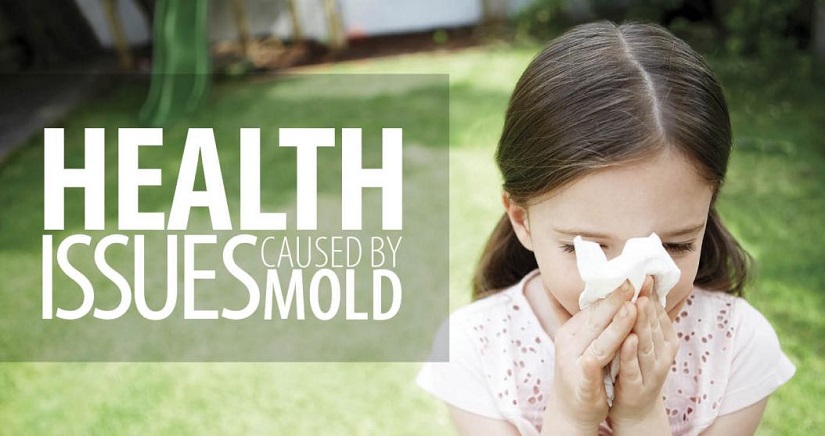
Rainbow Restoration explains why mold exposure poses significant health risks and why prompt attention is required.
|
Last Updated November 6, 2023
It is reported that there are at least 45 million buildings in the US that have unhealthy levels of mold. While mold is a naturally occurring substance, it can pose serious health risks when it’s left to grow unchecked indoors.
As soon as you suspect mold growth in your home, school, or business, it’s crucial to call professionals to treat and remove the infestation. The longer mold is left unattended, the more damage it will cause.
Why is Mold Toxic?
Mold is a naturally occurring fungus that lives on damp or decaying organic matter. It reproduces through microscopic spores, which exist virtually everywhere. While the spores aren’t visible to the naked eye, they can attach themselves to carpets, furniture fabrics, HVAC ductwork, and pets. Once they land on a spot with the appropriate growth conditions, they build up and become visible.
Mold growth inside your property is problematic for several reasons. The mold itself can be dangerous, causing respiratory problems for the property’s inhabitants, but it also means your space is damp. This moisture could mean your property is suffering from water damage, in some cases, of unknown origin.
Further, mold feasts on organic substances. In the wild, we see this as mushrooms growing in a forest and breaking down dead trees. Indoors, mold can grow on drywall, paper, wood, and other building materials.
Severe Risks Associated with Mold Damage
The danger of mold damage cannot be understated. Mold can be toxic if it appears to have a gray or soot-like texture or if it appears slimy and wet. Often, you’ll see furry orange or brown spots. These kinds of molds can negatively impact the quality of the air inside a property and, ultimately, your health and well-being.
Can Mold Make You Sick?
According to the Environmental Protection Agency, health risks from mold can range from allergic reactions to asthma or irritated eyes, ears, throats, and lungs.
Symptoms stemming from mold spore exposure may include:
- Nasal and sinus congestion
- Eye irritation
- Blurred vision
- Sore throat
- Chronic cough
- Skin rash
These risks are caused by airborne mold spores throughout the home or business, not only mold you can see on the walls, ceilings, and floors. This is why hiring a professional team to remove mold from your property is important to ensure complete remediation.
From Water Damage to Mold Growth
You can’t have mold without water. Water damage is commonly caused by faulty or leaky plumbing, clogged gutters and downspouts, failing appliances, and severe weather. Unfortunately, you may see mold growth before you realize your property has water damage.
According to the Federal Emergency Management Agency (FEMA), mold may begin to grow on damp surfaces in as little as 24-48 hours. In a matter of days, a relatively small water damage incident can begin to grow into a full mold infestation.
According to the Centers for Disease Control and Prevention (CDC), the most common indoor molds are:
- Cladosporium
- Penicillium
- Aspergillus
- Alternaria
- Stachybotrys chartarum (also known as black mold)
What Does Mold Need to Grow?
Mold requires the following to grow:
- Water (usually in the form of a moist environment)
- Food (dead organic substances to feed on, such as drywall, paper, wood, or other materials)
- Oxygen
- Temperatures between 40 and 100 degrees Fahrenheit
While mold can’t grow in temperatures below 40 degrees, spores can remain dormant until suitable conditions arise again.
Places Where Moisture Problems Are Common
Issues with moisture on your property are most likely the result of structural deficiencies.
Common areas of water damage inspection include:
- Rain leaks under windows, on roofs, and at wall joints
- Behind vinyl wallpaper
- Under other impermeable wall finishes such as faux brick
- Surface and groundwater leaks from poorly designed or faulty rain gutters, footing drains, or basement design issues.
- Plumbing leaks
- Stagnant water in appliances, including HVAC systems, humidifiers, dishwashers, washers, and refrigerators.
Professional Mold Removal Services
It can be tempting to grab the bleach and start cleaning once you realize there’s mold growth occurring on your property. However, simply cleaning with bleach and water will not kill mold.
Depending on the extent of the mold contamination, some degree of reconstruction may be required to return a property to its best possible condition. However, with early mold remediation, airborne illness and the need for reconstruction can often be prevented.
For IICRC-certified mold removal, request an appointment online or call for professional mold removal services in your area.
